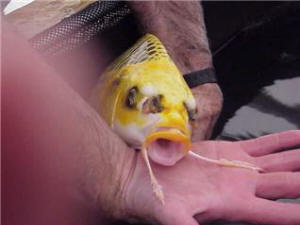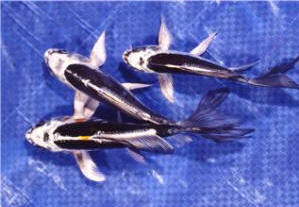 |
Aquatic Gardens
Ponds, Streams, Waterfalls & Fountains:
Volume 1. Design & Construction
Volume 2. Maintenance, Stocking, Examples
V. 1
Print and
eBook on Amazon
V. 2
Print and
eBook on Amazon
by Robert (Bob) Fenner |
 |
Transferring a very large Indoor goldfish in to an outdoor
pond? 9/1/2009
I have very large common goldfish he's 9.5 inches long 2.5 inches
wide and 4 inches high. He's on his own in a very large tank as he
seemed to bully the much smaller gold fish and Orfe i have.
<Happens>
I feel a little sorry for him on his own and he's recently come
into breeding season. I'm wanting to know if i can transfer him
into my out door pond with 6 Koi Carp.
<Mmm, maybe>
The pond has been established nearly 4 months now and we have had the 6
Koi in there for the last 3 months, they are very happy and swim around
in a pack they have doubled in size and would be as big as
my gold fish.
<Then you have good odds of them getting along, maybe even
interbreeding>
Not sure in the sex of the Koi carp, i live in North Yorkshire, UK and
if it is possible to transfer him is now the time to do it.
Many thanks
Sharon
<This is a good time of year to do this change/move. Bob Fenner, who
has a friend, roomie (family name Catterick) from your part of
York>
Re: Transferring a very large Indoor goldfish in to an
outdoor pond? 9/1/2009
Thanks for this Bob and roomie,
<Hi Sharon>
I will give it a go tomorrow, i have the rest of the week off so keep
an eye on him and make sure he's not chasing the other fish around
to much.
I think the pond would be an ideal size for him, i never seen a gold
fish so big. I rescued him from an empty house, so have no idea how old
he is.
<Can live a few decades>
Could i ask one more question, in the reading I've done it seems
that "The ripe females release pheromones which attracts the
attentions of all the males in the pond, which in turn drive and chase
each female (whether
ripe or not) to expel their eggs".
How would a lone male come into season?
<Really just temperature and light influences... can cross with
Cyprinus carpio... including Koi, Carp>
thanks again
Sharon
<Welcome. BobF>
|
Salt as a preventative
11/5/07 Hello Mr. Fenner,
Great site! I am impressed by all of the
knowledge that is packed into this web space. I however note the
lack (Did I miss it?) of mentioning the beneficial effects of
using salt for acclimating fish, especially Koi and Goldfish. We
have been using salt for about 16 years at our facility and the
difference in receiving and holding livestock is amazing. My
apologies if I did not see it mentioned at your site.
Thanks Jay D Doub Blue
Ridge Fish Inc. <Ahh! So glad to hear
from you... I have purchased Blue Ridge's pond fishes,
foods... for many years... The last big go I brought them in for
PetCo in the early nineties. I do agree with your mention here of
salt in acclimation. And will add this note with credit to you.
Cheers, Bob Fenner, who can't remember the ladies names in
the front office I used to deal with, but somewhere have the old
Christmas cards with the staff on them>
Re: Salt as a preventative
11/6/07 I work for our wholesale
division, the hatchery is on the other side of the large Mecca of
Kernersville NC. We wholesale a wide variety of aquatics
including saltwater while the hatchery sticks to just coldwater.
<Ahh! Blueridge HAS expanded... I recall when "Butterfly
Koi" was big news...> The lady you mention could be one
of four: Brenda, Delores, Regan, or Martha. <Ah, yes...
Brenda... How could I forget? The same name as my eldest
sister> Delores and her husband Wyatt Lefever sold the
hatchery to their eldest son Randy. <Oh> He and his
wife Karen own both the hatchery and our company. I have a few of
those Christmas cards as well! Give me an address and I will make
sure that a 5 lb. bag of Blue Ridge food makes its way to your
door. Since I only feed my koi between May and September you
can take a rain check if you like. Make sure to specify regular
pellet, small pellet or blend (contains both regular and large
pellet). It contains our new formulation with ENCAPCELL a
nucleotide product. http://www.theroangroup.net/uploads/Media_Releases.pdf
and here http://www.blueridgekoi.com/Blue%20Ridge%20Fish%20Hatchery%20Fish%20Food.htm
<The very small would be appreciated... Though I write
mainly about marines nowadays, I keep goldfish... 8586 Menkar
Rd., San Diego, Ca. 92126> Also I sent you a couple of pics of
Dotty, Foo Man Koi, and Tux Butterflies. Enjoy! Jay
<Very nice. Thank you for all... Always great to hear
from old friends, companies in the trade. Cheers, Bob
Fenner>
Salt as a preventative... and adjunct to Pondfish
acclimation. Neale's go 11/6/07 Hello Mr. Fenner,
Great site! I am impressed by all of the knowledge that is packed
into this web space. I however note the lack (Did I miss it?) of
mentioning the beneficial effects of using salt for acclimating
fish, especially Koi and Goldfish. We have been using salt for
about 16 years at our facility and the difference in receiving
and holding livestock is amazing. My apologies if I did not see
it mentioned at your site. Thanks Jay <Hello Bob, Jay. I'm
not a fan of the routine addition of salt to freshwater aquaria.
For a start, aquarists often misunderstand its purpose, and
imagine adding salt improves the hardness of soft water. It does
not. When used thus, there's a lot of anecdotal evidence that
fish such as Mbuna become prone to 'Malawi Bloat',
presumably because their osmoregulation system ends up having to
deal with a situation it hadn't evolved to handle. It
doesn't take a leap of imagination to suppose that fish
adapted to soft water environments, such as tetras, are likely to
be sensitive to salty water too. There's also this vague idea
that somehow adding tiny amounts of salt will prevent various
parasitic infections. While high concentrations of salt can be
used as a treatment, too many aquarists delay treating problems
like Finrot or fungus because they think adding a teaspoon of
salt per gallon will do the job for them and save them some money
at the same time. Of course it does nothing of the sort, and
their fish continue to get sick and often die because by the time
they do spend the money on a proper medication it is too late.
The only scientifically grounded use for salt is in reducing the
toxicity of nitrogenous wastes. Salt is widely used thus on
certain sorts of fish farms where the fish are kept confined in
ponds. Salt may also be useful when used this way in
retailer's tanks where overstocking is common, and while fish
are being shipped in cartons without filtration. But in a
well-maintained aquarium there shouldn't be any nitrate in
the water, and nitrate should be relatively low, so adding salt
becomes redundant. So just like activated carbon, aquarium salt
strikes me as Old School fishkeeping that provides no real
benefits other than handing money over to retailers and salt
manufacturers. There's nothing salt does that can't be
done better by proper filtration, regular water changes, and
proper management of water chemistry. I don't completely
decry salt for niche functions like treating Whitespot on copper-
and formalin-sensitive fish, but at the same time I consider it
Snake Oil of sorts as far as the regular aquarist with a
community tank goes. Cheers, Neale.> <<Mmm, well... I do
like "aquarium salt/s" (as in the mix of metals,
non-metals usually crudely derived from desalination via solar
power) for acclimation of pond fishes... I too
have found them to be efficacious in stabilizing "too
dry" larger koi and fancy goldfishes of size... and to some
degree, eliminating the bulk of external parasite fauna.
BobF>
|
|

 
|
Koi additions 1/12/06 HEY THERE Fellow
enthusiasts! <There you are Tom... long time, no chat> A couple
of years ago, I built a large (to us anyway) liner pond (Thanks for the
help Bob!). It is approximately 3600 GAL or
so. It has been doing wonderful and the fish are happy and
healthy. But here's the question. A friend of mine is
moving and can't take his (6) koi with him. He wants to
give them to me for my pond . I feel there is enough room in
the pond for them (only 5 fish right now) but am worried about adding
fish in the winter. <Mmm, yes... a tough time to move> Will the
bacteria be able to reproduce rapidly enough to keep up with the added
load in cold water? <Actually... likely so... there is very little
excretion of such in cold temperatures... the big troubles come about
from the actual fish being moved... more psycho-social than
physiological> I live in Northern VA and, although
winter hasn't truly visited us yet, the water is around the upper
40's (we stopped feeding in Nov when it dropped below 50).
<Mmm... I take it all the fish... yours and theirs are outdoors...
moving the koi expediently, switching water back and forth to
acclimate, provide oxygen... not raising water temperature much in
transition... should do it here> If this is in any way risky, I have
no problem housing the new fish (around 6 - 8" each) in the
basement in a 100 GAL stock tub with filter until the Spring. What are
your thoughts? <Better to mix in with your existing fish IMO>
Thanks so much for all that you fine folks do! Tom (The Tool Man)
<Be chatting, Bob Fenner>
Re: Koi additions 1/14/07 HEY
BOB! Yeah, it's been a long time! As
previously mentioned in your discussions, MOST of the answers to our
questions are covered on your site, so with a little searching, there
becomes less of a need to bother you and your folks. But it
is always good to "talk" to you! <Am glad for this...
otherwise, just moving about others "conversations" gets to
be too second-hand...> Although, sometimes, it does give hobbyists
the extra sense of peace to have it "directly from the horses
mouth"! ;) <Neigh!> I took your advice and
decided to just put them in our pond instead of indoors. The
only catch was that my friend was actually keeping them in his garage
in a 100 GAL Stock Tank (watering trough) so the temp difference was a
bit more than I would have liked. But it was an emergency
move. So I did the slow drip acclimation (much like what is recommended
for sensitive marine stock). When we got them home, their
water was 63* F and my pond temp was at 47* F. I dripped
them for 8 hours to get them temp absolutely right and keep them
aerated, then gently eased them into their new home. Wish us
luck! <I do... I had hoped that this was a "like for like"
pond to pond movement with the fish in and going to about the same
circumstances water quality wise... If they were in good shape, the
temperature difference shouldn't be overly problematical> As
always, I am humbled by the extent of the knowledge and caring of your
organization and hope to be able/knowledgeable enough in the future to
assist you with the site. <Me too!> Thank you and enjoy your time
in HI. I have only been once but it is a truly wonderful and
beautiful place. Tom (The Tool Man) <Thank you my friend. Cheers,
Bob Fenner>
Koi in the winter I have a 50,000 gallon outdoor
pond in Pittsburgh. It has a waterfalls. We have snow and
ice already. My local pet store has about 20 large (10-12inch) koi they
will give me "a deal" on. They said if I acclimate them
slowly they will be fine. Your opinion? (They are
inside now at 78 degrees) <Mmmm.... having been kept indoors without
biological cues for torpor, I don't think these fish can safely be
acclimated no matter how slowly you go. Some will surely live, and some
or many will surely die. Seems irresponsible to me... a waster of money
and life likely. I'd leave them at the store. Best case scenario...
a large makeshift pool in the garage at a cooler temp for the next 6 -8
weeks before sending outside. Feed winter food (wheat) sparingly until
you wane to a stop by the end of 8 weeks. Then acclimate to outside>
Thanks! Ron <best regards>
From Pond to Aquarium We would like to move 6 goldfish that
have spent most of their lives in a small outdoor pond to an indoor
aquarium. Four of these fish were born in this pond. The reason we want
to do this is because we are selling our house and do not want to leave
the fish behind. Is this possible to do? <Yes, not hard> If so,
what special steps would we have to take to acclimate our fish to their
new environment? <Best done during a "warmer" part
of the year (for thermal reasons), the fish can be moved by first
moving a good part of their water into the aquarium, allowing this
system to become established (a few weeks with the filter going)...
then moving them into said system, being careful (low) on feeding,
testing for ammonia, nitrite... If the tank is large enough (a good
10-15 gallons per fish plus), all should be well> Recommending some
articles to read online would be helpful. <I wish I knew of such...
perhaps you will write this> By the way, the fish are not overly
large, four inches in length at most. We have two fantails that are
quite fat. Thanks. Diana Weaver <Do keep records of what you did,
observed. And keep us informed. Bob Fenner>
koi Hi Robert, A blue heron has just eaten 6 of my 13 koi
& comets. I have since put a net over the pond, but the fish
won't come out of their houses I had made for them. I am sure they
are still frightened but am quite concerned about them. They have not
eaten in a week. Will they get over the scare and swim around as
before? They use to come to me as soon as they saw me for food. Thank
you for any help, Irene <Yes, your fish will recover, but this will
take a few more weeks to a couple of months... Do be vigilant about
keeping the netting in place... and consider placing motion activated
lighting and sound effects about the pond's exterior... Good luck,
life. Bob Fenner>
 |
Aquatic Gardens
Ponds, Streams, Waterfalls & Fountains:
Volume 1. Design & Construction
Volume 2. Maintenance, Stocking, Examples
V. 1
Print and
eBook on Amazon
V. 2
Print and
eBook on Amazon
by Robert (Bob) Fenner |
 |
|
|

